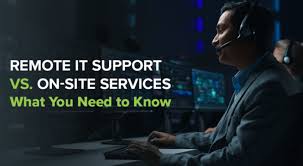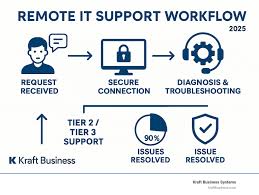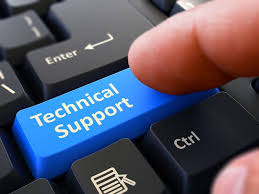Importance of Remote IT Support Services in the USA
In today’s fast-moving digital world, every U.S. business depends on technology. Remote it support services is the need. From small startups to large companies, reliable IT services keeps daily operations running smoothly. According to Statista, about 78% of small and medium businesses in the USA now use remote IT support services to manage their systems and reduce downtime.
A recent Forbes Tech Council report showed that companies using managed IT support had 63% fewer tech issues and saved thousands of dollars every year. Quick response and 24/7 monitoring mean problems get fixed before they cause major losses.
Cybersecurity is another big reason behind this shift. The average cost of a data breach in the USA reached $9.5 million in 2024, according to IBM. Remote IT support teams help prevent these risks with regular updates, system monitoring, and real-time protection.
The demand for remote IT services in the USA is growing fast — expected to rise over 11% each year through 2028. This growth shows that businesses now prefer flexible, affordable, and secure IT solutions instead of traditional in-house support.
In short, remote IT support helps American businesses stay secure, productive, and ready for the future. It’s not just support — it’s a smart investment for long-term success.

Remote IT Support Services USA: The Future of Smarter Business Operations
Running a business in the U.S. today means managing nonstop technology demands. Whether it’s protecting customer data, supporting hybrid teams, or keeping systems online 24/7 — technology can make or break success. That’s where Remote IT Support Services USA come in. These services don’t just fix issues; they build a stronger, more efficient, and secure digital foundation for your business.
ROI-Driven IT Support — Not Just Problem Solving
Many IT companies focus only on fixing problems. But smart business owners want results. The best remote IT support providers focus on ROI-driven outcomes — cutting downtime, reducing onsite labor, and optimizing system performance.
A recent survey shows that U.S. businesses using managed remote IT support save 35–50% annually on operational costs. Instead of paying for unexpected repairs, you invest in consistent uptime, performance monitoring, and faster workflows. That’s a direct boost to your bottom line.
24/7 Proactive IT Monitoring Powered by Predictive AI
Traditional support waits for something to break. Modern remote IT services prevent it from happening. Using AI-based predictive monitoring, your systems are watched 24/7 for unusual behavior.
AI can detect potential hardware failures or cyber threats before they cause damage. Companies using predictive tools have seen up to 90% fewer downtime incidents. This isn’t just “around-the-clock” support — it’s intelligent, preventive care that keeps your business running without interruptions.
Cyber Insurance Compatibility and Compliance Assurance
In the U.S., compliance and cyber insurance are serious business priorities. Businesses need to meet standards like HIPAA, SOC 2, or GDPR — or risk fines and higher premiums.
Advanced remote IT support companies ensure compliance by applying security frameworks that meet insurance requirements. This not only protects your business legally but can also lower your cyber insurance premiums — a benefit most companies overlook.
Scalability and Remote Workforce Integration
As more American companies move toward hybrid models, scalability is critical. Remote IT support makes it easy to add or remove users instantly without new hardware or infrastructure costs.
Whether your team grows from 20 to 200, remote IT support USA scales smoothly. It supports hybrid work environments, ensuring that your remote employees get the same security and access as those in the office.
Local U.S. Support with Global Expertise
Business owners in the U.S. prefer support that feels local — fast communication, same time zones, and cultural understanding. However, they also want global-level efficiency.
Top IT service providers USA combine both: U.S.-based engineers with international resources. This means quick response times, expert communication, and cost-effective service — the perfect balance between local trust and global reach.
Zero-Trust Security Architecture Integration
Today’s remote IT services go beyond antivirus software. They follow Zero-Trust Security Models — where every login, device, and data request is verified before access is granted.
This method prevents internal and external threats, especially for businesses that handle financial or healthcare data. A zero-trust framework adds another layer of confidence that your company’s systems stay safe, even in remote environments.
Transparent SLAs and Measurable Results
Transparency builds trust. That’s why top U.S. IT providers offer custom Service-Level Agreements (SLAs) with clear response times, ticket tracking, and monthly performance reports.
These reports help business owners see the exact value they’re getting — uptime percentages, issue resolution speed, and customer satisfaction ratings. When you can measure IT performance, you can improve it.
Seamless Integration with Business Productivity Tools
Every business depends on productivity platforms like Microsoft 365, Slack, Zoom, or Google Workspace. Remote IT support integrates directly with these tools, ensuring minimal disruption.
Imagine your systems, chats, and meetings all staying online — even during tech hiccups. That’s the real power of remote business IT support — it keeps people productive while keeping technology invisible in the background.
Disaster Recovery and Business Continuity
A single system failure can bring operations to a halt. That’s why remote IT support includes cloud-based disaster recovery and data continuity plans.
Modern U.S. IT providers offer automated backup and recovery under 10 minutes. So even during cyberattacks or natural disasters, your business stays up and running — with no lost data or downtime.
Real-Time IT Dashboards for Smarter Decisions
Transparency is a top priority for decision-makers. Advanced IT support companies now offer custom dashboards where business owners can monitor network health, uptime, open tickets, and even cyber threats in real time.
This gives executives visibility and control — something every U.S. business owner values when trusting an external IT provider.
Green IT and Energy Efficiency
Sustainability is no longer optional. Remote IT support reduces onsite hardware use, travel emissions, and energy waste. Many forward-thinking U.S. companies now include green IT strategies in their corporate goals.
By choosing remote support, you help the planet — and cut long-term costs at the same time.
Humanized IT Partnership — Not Just Outsourcing
U.S. businesses don’t want “cheap outsourcing.” They want partnerships built on trust and understanding. The best remote IT support companies act as strategic partners, aligning with your goals and working as part of your internal team.
This human-centered approach builds confidence, reduces stress, and leads to stronger business growth.
Multi-Cloud Optimization Expertise
Most U.S. companies now use multiple cloud platforms — AWS, Azure, and Google Cloud. Remote IT experts optimize workloads across these platforms, reducing costs and improving performance.
This cross-cloud management helps avoid vendor lock-ins and gives businesses more flexibility for scaling and innovation.
Industry-Specific Remote IT Support
Every industry has its own IT challenges. Leading U.S. IT providers tailor their solutions:
- Healthcare: HIPAA-compliant data management
- Finance: Encrypted transactions and risk monitoring
- E-Commerce: 24/7 uptime and payment security
Industry specialization sets apart true professionals from generalists.

Modern Tools and Techniques for Efficient Remote IT Support Services
1. Remote Monitoring and Management (RMM) Tools
Examples: NinjaOne, Atera, ConnectWise, SolarWinds
Why They’re Important:
RMM tools help IT teams monitor servers, networks, and devices remotely. They detect system errors, software updates, and performance issues in real time.
How They Improve Efficiency:
They allow proactive maintenance, meaning problems are fixed before users even notice them. This reduces downtime by up to 80% and increases system reliability.
Potential Risk:
If misconfigured, RMM tools can expose remote access points to cyber threats.
Solution:
Always enable multi-factor authentication (MFA) and zero-trust access policies to ensure only verified users can manage systems.
2. Secure Remote Access Tools
Examples: TeamViewer Tensor, AnyDesk, BeyondTrust Remote Support, Splashtop Business
Why They’re Important:
These tools let technicians connect to devices anywhere — securely and instantly.
How They Improve Efficiency:
They save on-site costs, reduce response time, and allow instant troubleshooting — critical for 24/7 U.S. business operations.
Potential Risk:
Weak authentication or outdated versions may open paths for hackers.
Solution:
Use encrypted connections (SSL/TLS), updated software, and session-based access to minimize risk.
3. Ticketing and Help Desk Systems
Examples: Zendesk, Freshdesk, ServiceNow, Jira Service Management
Why They’re Important:
Ticketing platforms organize support requests and prioritize urgent issues.
How They Improve Efficiency:
They ensure no customer issue is missed, improve communication, and provide transparent status tracking for both the company and client.
Potential Risk:
Data leaks from unsecured customer tickets or third-party integrations.
Solution:
Choose SOC 2 or ISO 27001-certified platforms and restrict API access to authorized users only.
4. Endpoint Detection and Response (EDR) Tools
Examples: CrowdStrike Falcon, SentinelOne, Sophos Intercept X
Why They’re Important:
EDR tools monitor every connected device (laptops, PCs, mobile) for suspicious behavior.
How They Improve Efficiency:
They automatically isolate infected systems, preventing network-wide cyberattacks. This saves businesses from data loss and downtime.
Potential Risk:
False positives can disrupt business workflows.
Solution:
Use AI-tuned EDR solutions and have human experts verify threats before taking automatic action.
5. Cloud Management Platforms
Examples: Microsoft Azure Monitor, AWS CloudWatch, Google Cloud Operations Suite
Why They’re Important:
Cloud management tools track and optimize resources used in cloud environments.
How They Improve Efficiency:
They enable cost optimization, faster deployment, and scalable performance — vital for growing U.S. businesses.
Potential Risk:
Poor configuration can expose sensitive data.
Solution:
Implement cloud access security brokers (CASB) and enforce role-based access control (RBAC).
6. Collaboration & Communication Tools
Examples: Microsoft Teams, Slack, Zoom, Google Workspace
Why They’re Important:
Communication is the heart of remote IT support. These tools keep technicians and clients connected in real time.
How They Improve Efficiency:
They ensure instant updates, quick troubleshooting discussions, and improved client satisfaction.
Potential Risk:
Shared channels may lead to data leakage or unauthorized access.
Solution:
Use secure file sharing, password-protected meetings, and admin-level controls for channels and data access.
7. AI-Powered Predictive Maintenance Tools
Examples: LogicMonitor, Auvik, Datadog AI
Why They’re Important:
AI tools predict system failures and security threats before they occur.
How They Improve Efficiency:
They reduce downtime by detecting issues early, providing real-time analytics, and automating repetitive maintenance tasks.
Potential Risk:
Over-dependence on AI can miss human context or critical manual checks.
Solution:
Use AI + human hybrid monitoring for accurate results and better decision-making.
8. Data Backup & Disaster Recovery Platforms
Examples: Veeam, Acronis, Carbonite, Backblaze
Why They’re Important:
Backup tools protect business data from ransomware, human errors, or natural disasters.
How They Improve Efficiency:
They enable instant restore capabilities and automatic cloud backups, minimizing downtime after a crisis.
Potential Risk:
Incomplete backups or failed restorations during emergencies.
Solution:
Regularly test recovery systems and use multi-location cloud storage for redundancy.

Why Remote IT Support Services Are the Smart Choice for U.S. Businesses
Remote IT support services help American businesses stay connected, secure, and productive without the cost of full-time in-house teams. From real-time troubleshooting to network security, these services give companies the flexibility to scale operations and handle tech issues instantly—anytime, anywhere
How Remote IT Support Services Improve Business Efficiency
Businesses across the U.S. rely on remote IT support services to minimize downtime and boost daily performance. With instant access to certified IT experts, companies resolve issues faster, protect data, and ensure smooth workflow. The result is stronger productivity and better customer satisfaction.
Key Features That Define Quality Remote IT Support Services
The best remote IT support services include 24/7 monitoring, data protection, cloud management, and proactive system updates. These tools and techniques keep your business running securely while cutting unnecessary expenses. A trusted remote IT partner ensures your technology always performs at its best.
Choosing the Right Partner for Remote IT Support Services in the USA
Selecting the right remote IT support services provider can make or break your business continuity. Look for certified experts, proven response times, and transparent pricing. A reliable provider not only fixes problems but also prevents them—helping your business stay competitive and future-ready
Top It support services companies in USA
| Company | What they do / Strengths | Known Ratings / Reviews / Age etc. | Pricing / Plan Info |
| Electric AI | USA-based remote help desk / IT device management / onboarding / cybersecurity. Zenkins | Not found exact star rating in source; marketed for small-/mid-sized businesses. (You’ll find reviews on G2 etc.) Zenkins | Not public details in that source; likely monthly subscription; check their site. Zenkins |
| Heroic Technologies | Managed IT support, help desk & cybersecurity, aimed at SMBs. U.S. tech engineers; flexible plans. Zenkins | Again, specific star count / total reviews not in that source. Age: not clearly given. | Pricing: Flexible monthly plans for SMBs; specific amounts not listed in that summary. Zenkins |
| HiredSupport | Small business IT / remote IT support outsourcing. Good for affordable options. HiredSupport | Rating: 4.9 stars on Clutch. Age: founded in 2016. Number of reviews: not fully given in snippet. HiredSupport | Pricing: starting from US$7/hour. HiredSupport |
| ScienceSoft | More established; compliance (ISO 9001, ISO 27001), help desk, remote technical support etc. HiredSupport | Age: founded 1989. Rating on Glassdoor ~4.4 stars (for internal reviews) etc. HiredSupport | Pricing: not clearly public; depends on type of support, ticket volume etc. HiredSupport |
| Bask Technology | Remote tech support & advising for consumers & small/medium businesses, based in Utah. Wikipedia | Age: since 2004. Number of employees ~200. BBB rating: A+, >50,000 members. Wikipedia | Pricing: Not in that source. Likely subscription or membership model given remote tech support/advising. Wikipedia |

FAQ’s: Remote IT support services
1. What are remote IT support services?
Remote IT support services allow technicians to solve computer, network, and software problems online without visiting your office.
2. How do remote IT support services help small businesses?
They save time and money by providing 24/7 expert support, fast issue resolution, and reduced downtime for small businesses.
3. Are remote IT support services secure?
Yes, trusted IT providers use encrypted connections, two-factor authentication, and data protection tools to keep your systems safe.
4. What’s included in remote IT support services?
These services cover network monitoring, data backup, help desk support, cybersecurity, and cloud management.
5. How fast can remote IT support services fix issues?
Most problems are diagnosed and resolved within minutes using advanced remote access tools.
6. What are the benefits of using remote IT support services in the USA?
You get nationwide coverage, 24/7 availability, lower costs, and access to top-certified IT experts anywhere in the U.S.
7. How do I choose the right remote IT support company?
Look for experience, customer reviews, response time, and strong data security policies before hiring.
8. Can remote IT support services handle cybersecurity threats?
Yes, many providers offer real-time monitoring, firewall management, and malware protection to prevent data breaches.
9. Are remote IT support services affordable for startups?
Absolutely. Many providers offer flexible monthly plans starting at under $100, making them perfect for startups and small firms.
10. What happens if remote IT support can’t fix my issue online?
If a problem needs on-site work, most companies send a local technician or guide your in-house team through the fix

Final Thoughts on Remote IT Support Services in the USA
In today’s fast-paced digital economy, remote IT support services are not just a convenience—they’re a necessity for U.S. businesses aiming to stay secure, efficient, and competitive. With the growing demand for 24/7 technical assistance, cybersecurity protection, and real-time troubleshooting, outsourcing IT tasks has become the smartest way to cut costs and boost productivity.
Whether you run a small startup or a nationwide enterprise, partnering with a reliable U.S.-based remote IT support provider ensures that your technology works seamlessly behind the scenes while you focus on growth. Companies like Remote Expert Solutions (RES) are redefining IT excellence by offering expert support, faster response times, and tailored solutions that keep your business ahead of the curve.
In short, the future belongs to businesses that embrace remote IT support services—because in the digital world, staying connected means staying successful.






